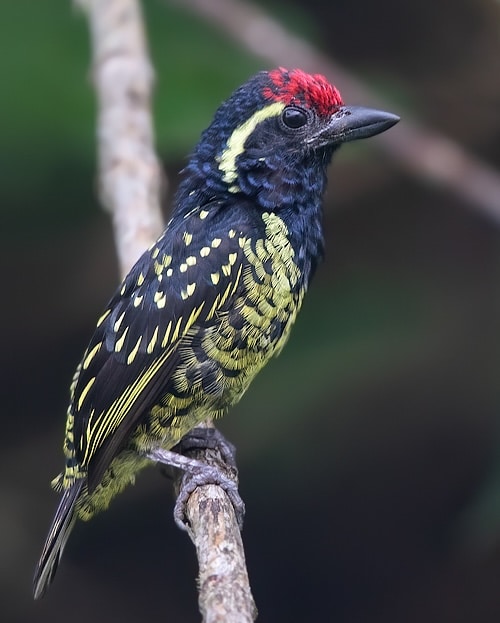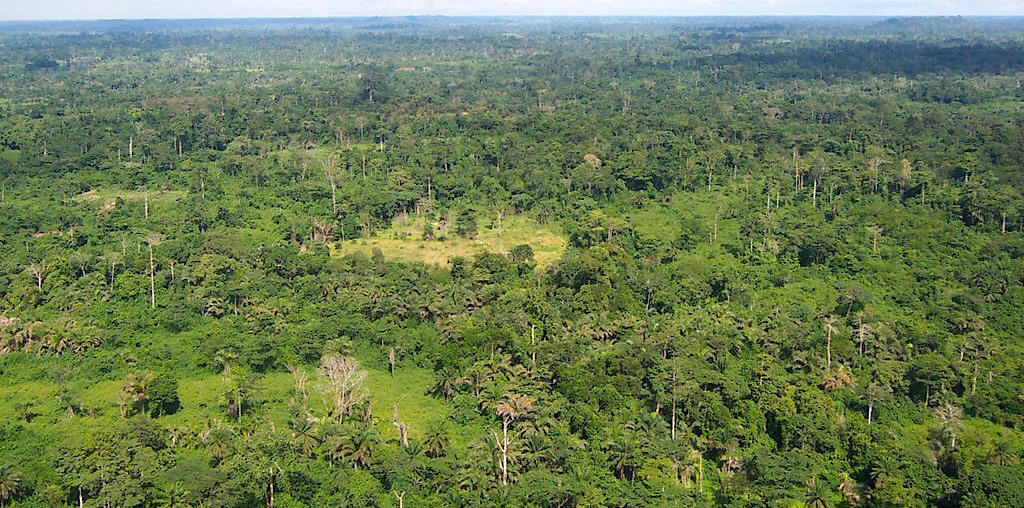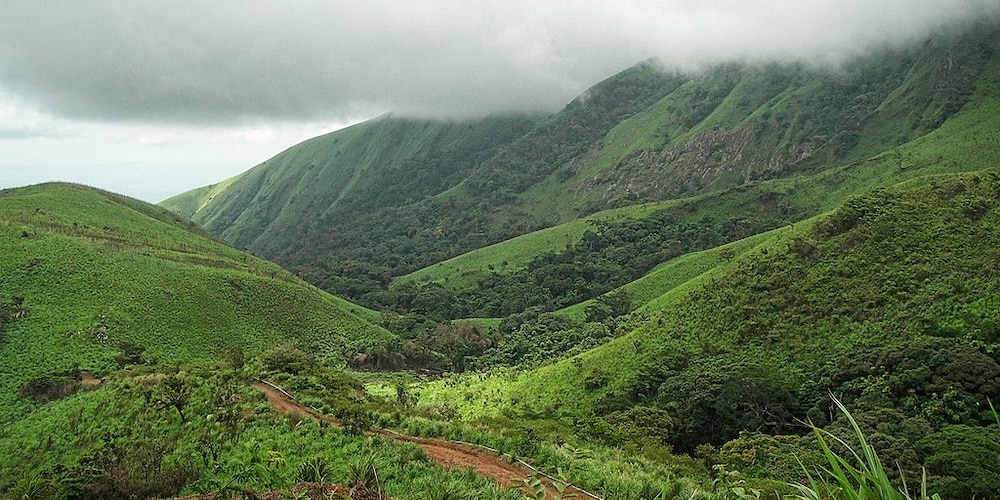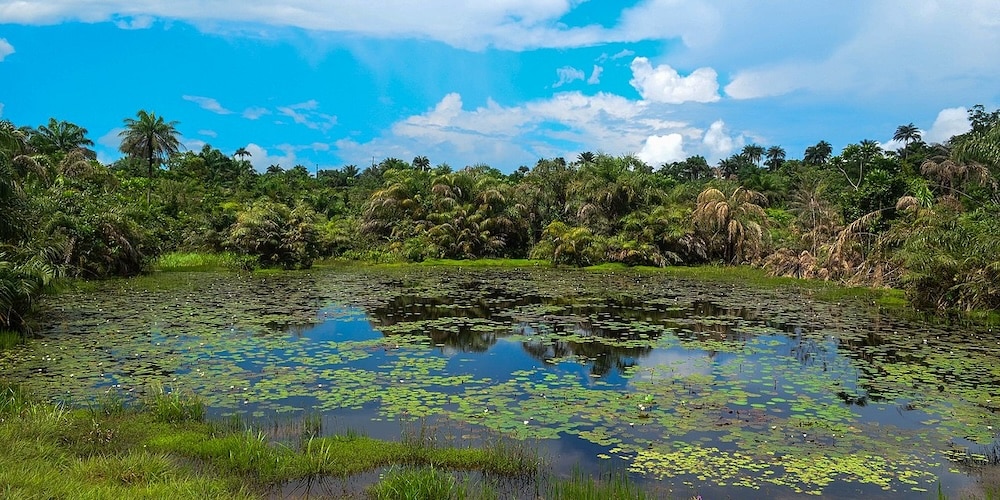Republic of Liberia

Liberia is a country on the West African coast. It is bordered by Sierra Leone to its northwest, Guinea to its north, Côte d’Ivoire to its east, and the Atlantic Ocean to its south and southwest. It has a population of around 5.6 million and covers an area of over 111,000 km2 (43,000 square miles). The official language is English. Over 20 indigenous languages are spoken, reflecting the country’s ethnic and cultural diversity. The capital and largest city with a population of around 1.75 million people is Monrovia. Although established as a country by freed or free-born African Americans and West Indians, it is now mixed ethnically and since several civil wars a stable democracy.
Historically, the Liberian economy depended heavily on iron ore and rubber exports, foreign direct investment, as well as the export of its other natural resources, such as timber. Agricultural products include livestock (goats, pigs, cattle) and rice, the staple food. Fish are raised on inland farms and caught along the coast.
The landscape is characterised by mostly flat to rolling coastal plains that contain mangroves and swamps, which rise to a rolling plateau and low mountains in the northeast. Tropical rainforests cover the hills, while elephant grass and semi-deciduous forests make up the dominant vegetation in the northern sections. Liberia’s watershed tends to move in a southwestern pattern toward the sea as new rains move down the forested plateau off the inland mountain range of Guinée Forestière, in Guinea. Cape Mount near the border with Sierra Leone receives the most precipitation in the nation.

Liberia’s Tropical Forest – ©USAID, Public domain, via Wikimedia Commons
Liberia’s main northwestern boundary is traversed by the Mano River while its southeast limits are bounded by the Cavalla River. Liberia’s three largest rivers are St. Paul exiting near Monrovia, the river St. John at Buchanan, and the Cestos River, all of which flow into the Atlantic. The Cavalla is the longest river in the nation at 510 km. The highest point wholly within Liberia is Mount Wuteve at 4,724 feet (1,440 m) above sea level in the northwestern Liberia range of the West Africa Mountains and the Guinea Highlands. Mount Nimba, near Yekepa, is higher at 1,752 metres (5,748 ft) above sea level, but is not wholly within Liberia as Nimba is located at the point where Liberia borders both Guinea and Ivory Coast. Nimba is thus the tallest mountain in those countries, as well and they share its surrounding nature reserve.

Mount Nimba Strict Nature – ©Guy Debonnet CC BY-SA 3.0 IGO via Wikimedia Commons
The equatorial climate, in the south of the country, is hot year-round with heavy rainfall from May to October with a short interlude in mid-July to August. During the winter months of November to March, dry dust-laden harmattan winds blow inland, causing many problems for residents. Because of its location, it is vulnerable to extreme weather, the coastal effects of sea level rise, and changing water systems and water availability.
Birding Liberia
Forests on the coastline are composed mostly of salt-tolerant mangrove trees, while the more sparsely populated inland has forests opening onto a plateau of drier grasslands. Liberia possesses about forty percent of the remaining Upper Guinean rainforest. Four terrestrial ecoregions lie within Liberia’s borders: Guinean montane forests, Western Guinean lowland forests, Guinean forest–savanna mosaic, and Guinean mangroves.

Monkey Island Mangroves – ©Erik Cleves Kristensen CC BY 2.0 via Wikimedia Commons
Liberia can be considered a biodiversity hotspot and has the highest remaining portion of the forests of the Upper Guinea Massif, containing many species endemic to the region. It has more than 2000 species of vascular plant including 225 timber tree species, 140 species of mammal, over 600 species of bird and 75 species of reptile and amphibian.
Evergreen forests in the south east of the country, which has very high rainfall, are characterised by dense vegetation with trees of varying heights. Sapo National Park exemplifies this forest type, and contains many endemic species. Moist semi-deciduous forest is found in the central and northwestern parts of the country with slightly lower rainfall. This has a more even height and a more open aspect. It is estimated that forest cover amounted to about 32% of the country’s area. There are eleven partially protected national forests.
The pygmy hippopotamus occurs in riverine forests inland, for example those beside the Lofa, Cestos and Cavalla Rivers. Liberia is its main habitat, with smaller populations in neighbouring countries. The African manatee also occurs along the coast and in many of the river systems. Other mammals found in the forests are leopards, monkeys, chimpanzees, antelopes, elephants and anteaters. The Liberian mongoose is probably the rarest mammal, none having been seen for years until one was captured in 1989; it is hunted for bushmeat and classified as vulnerable by the IUCN. The red river hog is much more common. Sapo National Park hosts around 125 species of mammal. These include the African golden cat, the drill, seven species of monkey, Gola malimbe and the Liberian mongoose. The park is also home to the African civet, giant forest hog, speckle-throated otter, seven species of duiker, the water chevrotain and three species of pangolins. About 530 species of butterfly are known, one of which is endemic.

Liberian Lagoon – ©blk24ga CC BY 3.0 via Wikimedia Commons
Rare bird species include the white-backed vulture, the hooded vulture and the Balearic shearwater. Lake Piso, a coastal lagoon, is one of five wetland sites in the country which have been designated as Ramsar sites. Larger birds found in the rainforest include parrots, woodpeckers and hornbills. Flamingos are found in the coastal swamps and lagoons. Other resident species are Black-collared Lovebird, Blue-headed Wood-dove, White-breasted Guineafowl and White-necked Rockfowl. The pepper bird (Common Bulbul) Pycnonotus barbatus is the national bird.
Around 590 species of bird have been recorded in Sapo National Park. These include White-breasted Guineafowl and White-necked Rockfowl, African fish eagle, African Grey Parrot, Great Blue Turaco and Woodland Kingfisher as well as a variety of egrets, hornbills, bee-eaters, rollers and sunbirds.
-
Wikipedia
GNU Free Documentation License
https://en.wikipedia.org/wiki/Liberia
-
Number of bird species: 695
(As at January 2025)National Bird: Common Bulbul (Pepperbird) Pycnonotus barbatus
-
Avibase
PDF ChecklistThis checklist includes all bird species found in Liberia , based on the best information available at this time. It is based on a wide variety of sources that I collated over many years. I am pleased to offer these checklists as a service to birdwatchers. If you find any error, please do not hesitate to report them. -
E-Bird
PDF ChecklistThis checklist is generated with data from eBird (ebird.org), a global database of bird sightings from birders like you. If you enjoy this checklist, please consider contributing your sightings to eBird. It is 100% free to take part, and your observations will help support birders, researchers, and conservationists worldwide. -
Forschungsstation Randecker Maar
PDF Annotated ChecklistThe Birds of Liberia -
Wikipedia
Annotated ListThis is a list of the bird species recorded in Liberia. The avifauna of Liberia include a total of 692 species, of which 4 have been introduced by humans. 21 species are globally threatened.
-
Birds of Liberia
| By Wulf Gatter | Christopher Helm | 2013 | Hardback | 320 pages, plates with 86 colour & 22 b/w photos, 4 plates with colour illustrations; 103 b/w illustrations, b/w distribution maps | ISBN: 9781408190227 Buy this book from NHBS.com -
Birds of Western Africa
| By Nik Borrow & Ron Demey | Helm | 2014 | Edition 2| Paperback | 592 pages, 266 plates with colour illustrations; colour distribution maps | ISBN: 9781472905680 Buy this book from NHBS.com -
The Birds of the Mount Nimba Region in Liberia
| By Peter Colston & Kai Curry-Lindahl | Natural History Museum Publications | 1986 | Hardback | 136 pages, colour & b/w illustrations, line drawings | Out of Print | ISBN: 9780565009823 Buy this book from NHBS.com
-
African Bird Club
WebpageLiberia is a small country with a bird list of about 617 species, a number of which are found in Liberia and a few adjacent countries only. There have been few ornithological expeditions to Liberia however, and much still remains to be discovered about the distribution of Liberian birds. With a recent civil war, lasting almost continuously from 1990 to 2003, the situation is not likely to improve for some time… -
Liberia Birder
WebsiteOur focuses include bird data collection and bird watching in Liberia, awareness raising, and capacity building for future conservation. We support bird and nature conservation through awareness, citizen engagement, and capacity building in Liberia. -
Monrovia Bird Haven
Facebook PageLocal bird enthusiasts unite! Conserve, learn, and have fun. -
Society for the Conservation of Nature of Liberia (SCNL)
WebsiteThe Society for the Conservation of Nature of Liberia (SCNL) was established in 1986 in response to the Liberian Business Law of 1976 for non-for-profit organizations with Business Registration Number: 051185951. The organization is a nongovernmental, non political and non for profit agency. -
West African Ornithological Society
WebsiteThe West African Ornithological Society grew out of the Nigerian Ornithologists
-
*Protected areas of Liberia
InformationSatellite ViewNational Parks, Ramsar Sites, National Forests etc -
IBAs
WebpageSatellite ViewAlmost the whole of Liberia falls within the Upper Guinea forests Endemic Bird Area (EBA) and all 15 of its endemic species are found. It also lies entirely within the Guinea-Congo Forest biome and 184 species characteristic of this biome have been found herein. Liberian Greenbul Phyllastrephus leucolepis has only been recorded from a limited area in the east of the country, while Gola Malimbe Malimbus ballmanni is almost entirely confined to Liberia… -
NP Grebo-Krahn National Park
InformationSatellite ViewThe park contains over 300 animal species, 270 plant species and serves as an important habitat for endangered and critically endangered species and subspecies, most notably the western chimpanzee, Diana monkey, king colobus, pygmy hippopotamus and giant pangolin The park has also been designated an Important Bird Area (IBA) by BirdLife International because it supports significant populations of many bird species. -
NP Lofa-Mano
InformationSatellite ViewThis site is 2,300 square kilometres (890 sq mi). The park was proposed to protect an area of unexploited forest in the north-west of the country, bordering Sierra Leone, an area described ecologically at the time as "certainly the most abundant in Liberia -
NP Sapo
InformationSatellite ViewIt contains the second-largest area of primary tropical rainforest in West Africa after Taï National Park in neighbouring Côte d'Ivoire. Sapo National Park is a "regional centre of endemism" and biodiversity, at one time hosting around 125 mammal species and 590 types of bird.
-
eBird
SightingseBirding This Month
-
BirdQuest
Tour OperatorLIBERIA & SIERRA LEONE – Little-known endemics of the Upper Guinea Forests -
Birding Africa
Tour OperatorOur Upper Guinea Specials Tour – combining Liberia and Sierre Leone – is one of several African tours that we have pioneered, and puts the comfort back into birding this little-known region. Gone are the tough hikes and rough camping required on other tours to Sierra Leone, without compromising on the birds. -
Ornis Birding Expeditions
Tour OperatorThis tour covers all accessible specialties of these two remote West African countries and in full comfort with no camping or long hikes! Birding in Liberia includes Mount Nimba, with Black-headed Rufous Warbler, Sierra Leone Prinia, Gola Malimbe, and Nimba Flycatcher as main targets.
-
2012 [02 February] - Alan G. Johnston
Report…Sunbirds included Variable, Olive-bellied, and, new for me, the Mouse-brown Sunbird, locally known as the Brown Sunbird. Also seen were Woodland and Pied Kingfishers, Little Bee-eater, Tawny-flanked Prinia, and Swamp Greenbul (Swamp Palm Bulbul). Our final bird of the morning was the most interesting. We saw a falcon swoop into the forest, then found it in a tree only 50 meters away and had a long look at a Red-footed Falcon. This was a first for Moses, and we are not aware of other records for Monrovia…. -
2020 [02 February] - Michael Mills
ReportThe first ever birding tour to Liberia and our first Upper Guinea Special Tour (Liberia and Sierra Leone, combined) provided some spectacular birds and birding in this little-known region...
-
Birding Liberia
InformationThe rich forests of Liberia provide sanctuary to such rare species as the Nimba flycatcher, Gola Malimbe and Yellow-bearded greenbul. Home to a staggering 50% of the world’s Upper Guinea, Liberia provides an exciting habitat for an incredible array of bird species and an exhilarating birding adventure for intrepid twitchers. -
Saving Liberia's Rainforests
WebsiteThe spectacular biodiversity of Liberia is clearly worth protecting: the forest supports 568 species of birds, 9 of which are endangered, as well as a wide range of plant and animal life. The forest is a unique ecological niche for several rare species, such as the white-breasted guinea fowl

